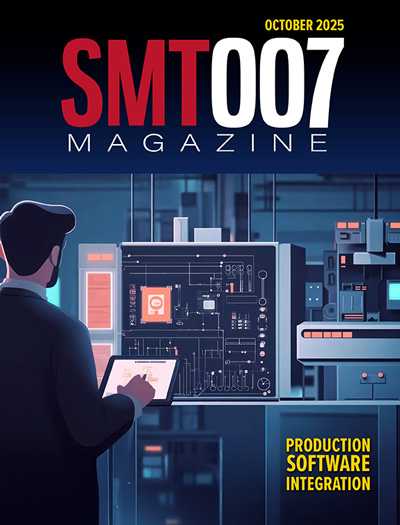-

- News
- Books
Featured Books
- smt007 Magazine
Latest Issues
Current Issue
Production Software Integration
EMS companies need advanced software systems to thrive and compete. But these systems require significant effort to integrate and deploy. What is the reality, and how can we make it easier for everyone?

Spotlight on India
We invite you on a virtual tour of India’s thriving ecosystem, guided by the Global Electronics Association’s India office staff, who share their insights into the region’s growth and opportunities.

Supply Chain Strategies
A successful brand is built on strong customer relationships—anchored by a well-orchestrated supply chain at its core. This month, we look at how managing your supply chain directly influences customer perception.
- Articles
- Columns
- Links
- Media kit
||| MENU - smt007 Magazine
ATS’ CPU Cooler for Dense PCBs Pulls in Air from Four Directions
February 17, 2022 | Advanced Thermal Solutions, Inc.Estimated reading time: 1 minute
Advanced Thermal Solutions, Inc. (ATS) is now providing quadFLOW active CPU coolers, designed to cool high powered chips in densely filled locations. quadFLOW active coolers pull air from four directions to maximize thermal performance where airflow is limited, and conventional cooling solutions are ineffective.
Many 1U and 2U servers have constrained internal airflow. This can make cooling today's highest-performing Intel, AMD and Nvidia chips difficult. If a cooling system can’t effectively manage chip heat, a processor may reduce its speed for safety, which can compromise computer performance. ATS quadFLOW coolers, drawing cooling air from four directions, are ideal for cooling such 1U and 2U systems and capable of handling a max TDP of 160W. Cooling performance is 20% higher than other coolers.
Provided standard with PEM attachment hardware, quadFLOW coolers are designed to precisely fit the ILM (Independent Loading Mechanism) retention device on Intel LGA 2011 (Socket R) and newer LGA 2066 (Socket R4) CPU sockets. The PEMs align with the mounting hole patterns in the LGA 2011 and LGA 2066 square ILM (80 x 80 MM) CPU sockets. An ATS backing plate allows quadFLOW’s use with AMD, Nvidia and other non-intel CPUs.
The blowers on quadFLOW active CPU coolers have a PWM (pulse width modulation): 10.8 VDC ~ 13.2 VDC operating voltage, with an MTBF of 598,000 hours measured at 40oC. When weight is an issue, choose quadFLOW coolers with aluminum fins. For higher performance, copper fins are available. When higher cooling levels are needed, quadFLOW coolers can be paired with a vapor chamber base.
quadFLOW coolers come with pre-attached Parker Chomerics high performance (3.0 W/m-k thermal conductivity) T670 thermal grease. T670 supports high power applications requiring minimum bond line thickness.
Testimonial
"We’re proud to call I-Connect007 a trusted partner. Their innovative approach and industry insight made our podcast collaboration a success by connecting us with the right audience and delivering real results."
Julia McCaffrey - NCAB GroupSuggested Items
Episode 6 of Ultra HDI Podcast Series Explores Copper-filled Microvias in Advanced PCB Design and Fabrication
10/15/2025 | I-Connect007I-Connect007 has released Episode 6 of its acclaimed On the Line with... American Standard Circuits: Ultra High Density Interconnect (UHDI) podcast series. In this episode, “Copper Filling of Vias,” host Nolan Johnson once again welcomes John Johnson, Director of Quality and Advanced Technology at American Standard Circuits, for a deep dive into the pros and cons of copper plating microvias—from both the fabricator’s and designer’s perspectives.
Nolan’s Notes: Tariffs, Technologies, and Optimization
10/01/2025 | Nolan Johnson -- Column: Nolan's NotesLast month, SMT007 Magazine spotlighted India, and boy, did we pick a good time to do so. Tariff and trade news involving India was breaking like a storm surge. The U.S. tariffs shifted India from one of the most favorable trade agreements to the least favorable. Electronics continue to be exempt for the time being, but lest you think that we’re free and clear because we manufacture electronics, steel and aluminum are specifically called out at the 50% tariff levels.
MacDermid Alpha & Graphic PLC Lead UK’s First Horizontal Electroless Copper Installation
09/30/2025 | MacDermid Alpha & Graphic PLCMacDermid Alpha Electronics Solutions, a leading supplier of integrated materials and chemistries to the electronics industry, is proud to support Graphic PLC, a Somacis company, with the installation of the first horizontal electroless copper metallization process in the UK.
Electrodeposited Copper Foils Market to Grow by $11.7 Billion Over 2025-2032
09/18/2025 | Globe NewswireThe global electrodeposited copper foils market is poised for dynamic growth, driven by the rising adoption in advanced electronics and renewable energy storage solutions.
MacDermid Alpha Showcases Advanced Interconnect Solutions at PCIM Asia 2025
09/18/2025 | MacDermid Alpha Electronics SolutionsMacDermid Alpha Electronic Solutions, a global leader in materials for power electronics and semiconductor assembly, will showcase its latest interconnect innovations in electronic interconnect materials at PCIM Asia 2025, held from September 24 to 26 at the Shanghai New International Expo Centre, Booth N5-E30


